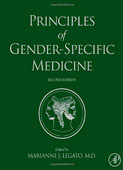Principles of Gender-Specific Medicine
The field of gender-specific medicine examines how normal human biology and physiology differs between men and women and how the diagnosis and treatment of disease differs as a function of gender. This revealing research covers various conditions that predominantly occur in men as well conditions that predominantly occur in women. Among the areas of greatest difference are cardiovascular disease, mood disorders, the immune system, lung cancer as a consequence of smoking, osteoporosis, diabetes, obesity, and infectious diseases.
The Second Edition of Principles of Gender-Specific Medicine will decrease in size from two to one volume and focus on the essentials of gender-specific medicine. In response to the market as well as many of the reviewers’ suggestions, the Editor has eliminated approximately 55 chapters from the first edition to make the book more compact and more focused on the essentials of gender-specific medicine. The content will be completely updated, redundant sections and chapters will be merged with others that are more relevant to the current study of sex and gender differences in human physiology and pathophysiology.
- Editor has eliminated approximately 55 chapters from the first edition to make the book more compact and more focused on the essentials of gender-specific medicine.
- Longer bibliographies and suggested reviews/papers of particular relevance and importance will be added at the end of each section.
- Each author will be asked to include recent meta-analysis of data
- Each chapter will progress translationally from the basic science to the clinical applications of gender-specific therapies, drugs, or treatments
- Section on drug metabolism will be eliminated but the subject will be incorporated into each relevant chapter
- Section on aging will be eliminated but age will be considered as a variable in each of the separate chapters

